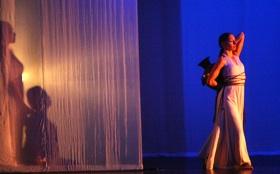“Miriam’s Well,” billed as “an interfaith collaboration of sacred dance, music, and poetry,” begins and ends with a poem by Coleman Barks, popular scholar of the Sufi mystic poet Rumi:
What is praised is one, so the praise is one, too,
Many jugs being poured into one huge basin.
All religions, all this singing, one song.
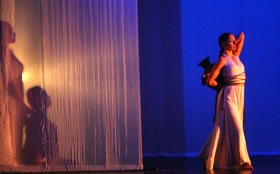
Photos by Shalom Ormsby
The chief heroine of “Miriam’s Well” happens to share her name with choreographer and artistic director Miriam Peretz. Yet any identification of Peretz with her subject is neither naive nor egotistic, judging from the spirit of selfless praise and generosity that suffused Saturday’s performance at the Julia Morgan Theater in Berkeley. The production repeats June 18 at Grace Cathedral in San Francisco, a space where it will surely play to even more resonant effect. This is a thoughtfully shaped and sensuously performed 90-minute celebration, driven by powerful, refined dancing and fully engaged musicianship.
A masterful performer of dances from the Silk Road and the Middle East, Peretz has brought together the three Abrahamic faiths through three similar female figures. Water imagery unites the Miriam of Judaism, whose well was said to follow the Jews through their exile in the desert; the virgin mother Mary of Christianity; and her representation as Maryam in the Koran. Peretz has also brought together a rich group of talent: seven well-trained dancers in flowing skirts and waist-length braided hair; the throaty spoken-word performer Lana Nasser, who beguilingly delivers all the show’s text; and the Qadim Ensemble, with its mélange of accordion, oud, guitar, percussive instruments of motley cultures, and plaintive, yearning vocals.
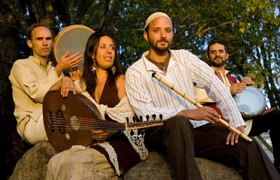
A musical ethnologist might be required to parse the traditions called on, and the movement styles of Peretz’s fusion choreography are similarly tricky to disentangle. The most fully realized moments present a hypnotic dream of living iconography. In “Miriam’s Well,” Peretz pours her offering of water before an altar, extracts a billowing blue silk from the vessel, and manipulates it ever more kaleidoscopically through propeller twirls.
In the next section, “Mother of Compassion,” Hannah Romanowsky becomes the Virgin Mary, stretching a blue shawl over her head and holding up her palms in a gesture of serenity and palpable caring, to Evelie Delfino Sales Posch’s Mediterranean-tinged setting of Ave Maria. And in “Light of the Beginning,” Aliah Najambadi becomes Islam’s Maryam, giving birth alone on a riverbank.
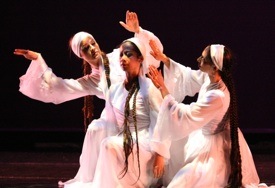
Unfortunately, it is just after Najambadi’s dramatization of the birth that “Miriam’s Well” flags; the long solo that follows, choreographed by Najambadi herself, is not distinct enough from the two preceding it, and Najambadi does not have the same intensity of energy as the other two women.
The show continues to lose traction through two ensemble dance pieces, before vaulting into ecstasy with a closing finale of dervishlike whirling.
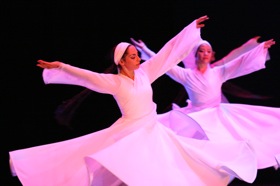
The whirling continues for a good 10 minutes, gorgeously performed and entrancing. In the earlier sections, these dancers’ flexible backs and fluttering, articulate hands particularly dazzled, but in virtuosic whirling their devotion seems to find full release. The homespun backdrop of the Julia Morgan Theater’s stage, with its rudimentary lighting capabilities, melted away.
The dancing should be even more beautiful to behold in the vaulted space of Grace Cathedral, where the vocals of Rachel Valfer Sills, Eliyahu Sills-Ney, and Bon Meryl Singer and a rousing daf solo from Pezham Akhavass will echo against stone walls. Still, “Miriam’s Well” would be an inspiring experience in any location.

